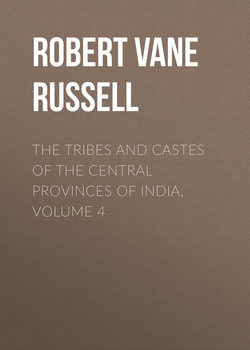Читать книгу The Tribes and Castes of the Central Provinces of India, Volume 4 - Robert Vane Russell - Страница 118
Part II
Articles on Castes and Tribes
Kumhār—Yemkala
Vol. IV
Mahār
10. Adoption of foreign religions
ОглавлениеIn Berār and Bombay the Mahārs have some curious forms of belief. “Of the confusion which obtains in the Mahār theogony the names of six of their gods will afford a striking example. While some Mahārs worship Vithoba, the god of Pandharpur, others revere Varuna’s twin sons, Meghoni and Deghoni, and his four messengers, Gabriel, Azrael, Michael and Anādin, all of whom they say hail from Pandharpur.”124 The names of archangels thus mixed up with Hindu deities may most probably have been obtained from the Muhammadans, as they include Azrael; but in Gujarāt their religion appears to have been borrowed from Christianity. “The Karia Dhedas have some rather remarkable beliefs. In the Satya Yug the Dhedas say they were called Satyas; in the Dvāpar Yug they were called Meghas; in the Treta Yug, Elias; and in the Kāli Yug, Dhedas. The name Elias came, they say, from a prophet Elia, and of him their religious men have vague stories; some of them especially about a famine that lasted for three years and a half, easily fitting into the accounts of Elijah in the Jewish Scriptures. They have also prophecies of a high future in store for their tribe. The king or leader of the new era, Kuyām Rai by name, will marry a Dheda woman and will raise the caste to the position of Brāhmans. They hold religious meetings or ochhavas, and at these with great excitement sing songs full of hope of the good things in store for them. When a man wishes to hold an ochhava he invites the whole caste, and beginning about eight in the evening they often spend the night in singing. Except perhaps for a few sweetmeats there is no eating or drinking, and the excitement is altogether religious and musical. The singers are chiefly religious Dhedas or Bhagats, and the people join in a refrain ‘Avore Kuyām Rai Rāja’, ‘Oh! come Kuyām Rai, our king.’”125 It seems that the attraction which outside faiths exercise on the Mahārs is the hope held out of ameliorating the social degradation under which they labour, itself an outcome of the Hindu theory of caste. Hence they turn to Islām, or to what is possibly a degraded version of the Christian story, because these religions do not recognise caste, and hold out a promise to the Mahār of equality with his co-religionists, and in the case of Christianity of a recompense in the world to come for the sufferings which he has to endure in this one. Similarly, the Mahārs are the warmest adherents of the Muhammadan saint Sheikh Farīd, and flock to the fairs held in his honour at Girar in Wardha and Partāpgarh in Bhandāra, where he is supposed to have slain a couple of giants.126 In Berār127 also they revere Muhammadan tombs. The remains of the Muhammadan fort and tank on Pimpardol hill in Jalgaon tāluk are now one of the sacred places of the Mahārs, though to the Muhammadans they have no religious associations. Even at present Mahārs are inclined to adopt Islām, and a case was recently reported when a body of twenty of them set out to do so, but turned back on being told that they would not be admitted to the mosque.128 A large proportion of the Mahārs are also adherents of the Kabīrpanthi sect, one of the main tenets of whose founder was the abolition of caste. And it is from the same point of view that Christianity appeals to them, enabling European missionaries to draw a large number of converts from this caste. But even the Hindu attitude towards the Mahārs is not one of unmixed intolerance. Once in three or four years in the southern Districts, the Panwārs, Mahārs, Pankas and other castes celebrate the worship of Nārāyan Deo or Vishnu, the officiating priest being a Mahār. Members of all castes come to the Panwār’s house at night for the ceremony, and a vessel of water is placed at the door in which they wash their feet and hands as they enter; and when inside they are all considered to be equal, and they sit in a line and eat the same food, and bind wreaths of flowers round their heads. After the cock crows the equality of status is ended, and no one who goes out of the house can enter again. At present also many educated Brāhmans recognise fully the social evils resulting from the degraded position of the Mahārs, and are doing their best to remove the caste prejudices against them.
124
Berār Census Report, l.c.
125
Bombay Gazetteer, Gujarat Hindus.
126
It was formerly suggested that the fact of the Mahars being the chief worshippers at the shrines of Sheikh Farīd indicated that the places themselves had been previously held sacred, and had been annexed by the Muhammadan priests; and the legend of the giant, who might represent the demonolatry of the aboriginal faith, being slain by the saint might be a parable, so to say, expressing this process. But in view of the way in which the Mehtars worship Musalmān saints, it seems quite likely that the Mahārs might do so for the same reason, that is, because Islām partly frees them from the utter degradation imposed by Hinduism. Both views may have some truth. As regards the legends themselves, it is highly improbable that Sheikh Farid, a well-known saint of northern India, can ever have been within several hundred miles of either of the places with which they connect him.
127
From Mr. C. Brown’s notes.
128
C.P. Police Gazette.
